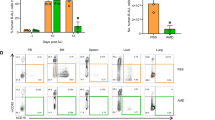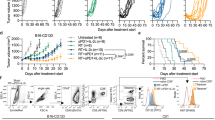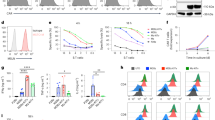Abstract
Cytopenia represents a significant complication after chemotherapy, irradiation before bone marrow (BM) transplantation or as a therapy for cancer. The mechanisms that determine the pace of BM recovery are not fully understood. During the recovery phase after chemotherapy or irradiation, the signals for retention of white blood cells within the BM increase significantly. This leads to a delay in the release of WBC, which can be overcome by targeting the CXCR4 axis with the antagonist 4F-benzoyl-TN14003 (T140). The delay in the release of WBC is also accompanied by suppression in the production of progenitor cells and mature cells by the BM stroma. Administration of T140 to mice transplanted with BM cells stimulates the production of all types of progenitors and mature cells, and increases the exit of mature cells to the periphery. Moreover, addition of T140, but not AMD3100, to BM stromal cultures stimulates the production of mature cells and progenitors from all lineages. The unique ability of the CXCR4 antagonist, T140 to stimulate the production and exit of WBC cells may be used as a novel therapeutic approach to overcome cytopenia associated with treatments for cancer and BM transplantation.
This is a preview of subscription content, access via your institution
Access options
Subscribe to this journal
Receive 12 print issues and online access
$259.00 per year
only $21.58 per issue
Buy this article
- Purchase on Springer Link
- Instant access to full article PDF
Prices may be subject to local taxes which are calculated during checkout






Similar content being viewed by others
References
Wright DE, Wagers AJ, Gulati AP, Johnson FL, Weissman IL . Physiological migration of hematopoietic stem and progenitor cells. Science 2001; 294: 1933–1936.
Abkowitz JL, Robinson AE, Kale S, Long MW, Chen J . Mobilization of hematopoietic stem cells during homeostasis and after cytokine exposure. Blood 2003; 102: 1249–1253.
Aiuti A, Webb IJ, Bleul C, Springer T, Gutierrez-Ramos JC . The chemokine SDF-1 is a chemoattractant for human CD34+ hematopoietic progenitor cells and provides a new mechanism to explain the mobilization of CD34+ progenitors to peripheral blood. J Exp Med 1997; 185: 111–120.
Dar A, Kollet O, Lapidot T . Mutual, reciprocal SDF-1/CXCR4 interactions between hematopoietic and bone marrow stromal cells regulate human stem cell migration and development in NOD/SCID chimeric mice. Exp Hematol 2006; 34: 967–975.
Li Z, Li L . Understanding hematopoietic stem-cell microenvironments. Trends Biochem Sci 2006; 31: 589–595.
Yin T, Li L . The stem cell niches in bone. J Clin Invest 2006; 116: 1195–1201.
Kollet O, Petit I, Kahn J, Samira S, Dar A, Peled A et al. Human CD34(+)CXCR4(−) sorted cells harbor intracellular CXCR4, which can be functionally expressed and provide NOD/SCID repopulation. Blood 2002; 100: 2778–2786.
Lapidot T, Kollet O . The essential roles of the chemokine SDF-1 and its receptor CXCR4 in human stem cell homing and repopulation of transplanted immune-deficient NOD/SCID and NOD/SCID/B2m(null) mice. Leukemia 2002; 16: 1992–2003.
Levesque JP, Hendy J, Takamatsu Y, Simmons PJ, Bendall LJ . Disruption of the CXCR4/CXCL12 chemotactic interaction during hematopoietic stem cell mobilization induced by GCSF or cyclophosphamide. J Clin Invest 2003; 111: 187–196.
Kim CH, Broxmeyer HE . In vitro behavior of hematopoietic progenitor cells under the influence of chemoattractants: stromal cell-derived factor-1, steel factor, and the bone marrow environment. Blood 1998; 91: 100–110.
Trent JO, Wang ZX, Murray JL, Shao W, Tamamura H, Fujii N et al. Lipid bilayer simulations of CXCR4 with inverse agonists and weak partial agonists. J Biol Chem 2003; 278: 47136–47144.
Zhang WB, Navenot JM, Haribabu B, Tamamura H, Hiramatu K, Omagari A et al. A point mutation that confers constitutive activity to CXCR4 reveals that T140 is an inverse agonist and that AMD3100 and ALX40-4C are weak partial agonists. J Biol Chem 2002; 277: 24515–24521.
Broxmeyer HE, Orschell CM, Clapp DW, Hangoc G, Cooper S, Plett PA et al. Rapid mobilization of murine and human hematopoietic stem and progenitor cells with AMD3100, a CXCR4 antagonist. J Exp Med 2005; 201: 1307–1318.
Abraham M, Biyder K, Begin M, Wald H, Weiss ID, Galun E et al. Enhanced unique pattern of hematopoietic cell mobilization induced by the CXCR4 antagonist 4F-benzoyl-TN14003. Stem Cells 2007; 25: 2158–2166.
Zuluaga AF, Salazar BE, Rodriguez CA, Zapata AX, Agudelo M, Vesga O . Neutropenia induced in outbred mice by a simplified low-dose cyclophosphamide regimen: characterization and applicability to diverse experimental models of infectious diseases. BMC Infect Dis 2006; 6: 55.
Petit I, Szyper-Kravitz M, Nagler A, Lahav M, Peled A, Habler L et al. G-CSF induces stem cell mobilization by decreasing bone marrow SDF-1 and up-regulating CXCR4. Nat Immunol 2002; 3: 687–694.
Welte K, Gabrilove J, Bronchud MH, Platzer E, Morstyn G . Filgrastim (r-metHuG-CSF): the first 10 years. Blood 1996; 88: 1907–1929.
Kaushansky K . Lineage-specific hematopoietic growth factors. N Engl J Med 2006; 354: 2034–2045.
Nie Y, Han YC, Zou YR . CXCR4 is required for the quiescence of primitive hematopoietic cells. J Exp Med 2008; 205: 777–783.
Sternberg D, Peled A, Shezen E, Abramsky O, Jiang W, Bertolero F et al. Control of stroma-dependent hematopoiesis by basic fibroblast growth factor: stromal phenotypic plasticity and modified myelopoietic functions. Cytokines Mol Ther 1996; 2: 29–38.
Zipori D, Lee F . Introduction of interleukin-3 gene into stromal cells from the bone marrow alters hemopoietic differentiation but does not modify stem cell renewal. Blood 1988; 71: 586–596.
Hattori K, Heissig B, Tashiro K, Honjo T, Tateno M, Shieh JH et al. Plasma elevation of stromal cell-derived factor-1 induces mobilization of mature and immature hematopoietic progenitor and stem cells. Blood 2001; 97: 3354–3360.
Fibbe WE, Pruijt JF, van Kooyk Y, Figdor CG, Opdenakker G, Willemze R . The role of metalloproteinases and adhesion molecules in interleukin-8-induced stem-cell mobilization. Semin Hematol 2000; 37 (1 Suppl 2): 19–24.
Pruijt JF, Fibbe WE, Laterveer L, Pieters RA, Lindley IJ, Paemen L et al. Prevention of interleukin-8-induced mobilization of hematopoietic progenitor cells in rhesus monkeys by inhibitory antibodies against the metalloproteinase gelatinase B (MMP-9). Proc Natl Acad Sci USA 1999; 96: 10863–10868.
van Os R, van Schie ML, Willemze R, Fibbe WE . Proteolytic enzyme levels are increased during granulocyte colony-stimulating factor-induced hematopoietic stem cell mobilization in human donors but do not predict the number of mobilized stem cells. J Hematother Stem Cell Res 2002; 11: 513–521.
Mohle R, Haas R, Hunstein W . Expression of adhesion molecules and c-kit on CD34+ hematopoietic progenitor cells: comparison of cytokine-mobilized blood stem cells with normal bone marrow and peripheral blood. J Hematother 1993; 2: 483–489.
Tavor S, Petit I, Porozov S, Avigdor A, Dar A, Leider-Trejo L et al. CXCR4 regulates migration and development of human acute myelogenous leukemia stem cells in transplanted NOD/SCID mice. Cancer Res 2004; 64: 2817–2824.
Lapidot T, Dar A, Kollet O . How do stem cells find their way home? Blood 2005; 106: 1901–1910.
Kollet O, Spiegel A, Peled A, Petit I, Byk T, Hershkoviz R et al. Rapid and efficient homing of human CD34(+)CD38(-/low)CXCR4(+) stem and progenitor cells to the bone marrow and spleen of NOD/SCID and NOD/SCID/B2m(null) mice. Blood 2001; 97: 3283–3291.
Bhana N . Granulocyte colony-stimulating factors in the management of chemotherapy-induced neutropenia: evidence based review. Curr Opin Oncol 2007; 19: 328–335.
Huston A, Lyman GH . Agents under investigation for the treatment and prevention of neutropenia. Expert Opin Investig Drugs 2007; 16: 1831–1840.
Rosu-Myles M, Bhatia M . SDF-1 enhances the expansion and maintenance of highly purified human hematopoietic progenitors. Hematol J 2003; 4: 137–145.
Lataillade JJ, Clay D, Bourin P, Herodin F, Dupuy C, Jasmin C et al. Stromal cell-derived factor 1 regulates primitive hematopoiesis by suppressing apoptosis and by promoting G(0)/G(1) transition in CD34(+) cells: evidence for an autocrine/paracrine mechanism. Blood 2002; 99: 1117–1129.
Hodohara K, Fujii N, Yamamoto N, Kaushansky K . Stromal cell-derived factor-1 (SDF-1) acts together with thrombopoietin to enhance the development of megakaryocytic progenitor cells (CFU-MK). Blood 2000; 95: 769–775.
Gibellini D, Bassini A, Re MC, Ponti C, Miscia S, Gonelli A et al. Stroma-derived factor 1alpha induces a selective inhibition of human erythroid development via the functional upregulation of Fas/CD95 ligand. Br J Haematol 2000; 111: 432–440.
Cashman J, Clark-Lewis I, Eaves A, Eaves C . Stromal-derived factor 1 inhibits the cycling of very primitive human hematopoietic cells in vitro and in NOD/SCID mice. Blood 2002; 99: 792–799.
Dale DC . Colony-stimulating factors for the management of neutropenia in cancer patients. Drugs 2002; 62 (Suppl 1): 1–15.
Bedell C . Pegfilgrastim for chemotherapy-induced neutropenia. Clin J Oncol Nurs 2003; 7: 55–56, 63–64.
Devine SM, Flomenberg N, Vesole DH, Liesveld J, Weisdorf D, Badel K et al. Rapid mobilization of CD34+ cells following administration of the CXCR4 antagonist AMD3100 to patients with multiple myeloma and non-Hodgkin's lymphoma. J Clin Oncol 2004; 22: 1095–1102.
Grignani G, Perissinotto E, Cavalloni G, Carnevale Schianca F, Aglietta M . Clinical use of AMD3100 to mobilize CD34+ cells in patients affected by non-Hodgkin's lymphoma or multiple myeloma. J Clin Oncol 2005; 23: 3871–3872; author reply 2–3.
Hendrix CW, Collier AC, Lederman MM, Schols D, Pollard RB, Brown S et al. Safety, pharmacokinetics, and antiviral activity of AMD3100, a selective CXCR4 receptor inhibitor, in HIV-1 infection. J Acquir Immune Defic Syndr 2004; 37: 1253–1262.
Heissig B, Hattori K, Dias S, Friedrich M, Ferris B, Hackett NR et al. Recruitment of stem and progenitor cells from the bone marrow niche requires MMP-9 mediated release of kit-ligand. Cell 2002; 109: 625–637.
Lichterfeld M, Martin S, Burkly L, Haas R, Kronenwett R . Mobilization of CD34+ haematopoietic stem cells is associated with a functional inactivation of the integrin very late antigen 4. Br J Haematol 2000; 110: 71–81.
Craddock CF, Nakamoto B, Andrews RG, Priestley GV, Papayannopoulou T . Antibodies to VLA4 integrin mobilize long-term repopulating cells and augment cytokine-induced mobilization in primates and mice. Blood 1997; 90: 4779–4788.
Hidalgo A, Sanz-Rodriguez F, Rodriguez-Fernandez JL, Albella B, Blaya C, Wright N et al. Chemokine stromal cell-derived factor-1alpha modulates VLA-4 integrin-dependent adhesion to fibronectin and VCAM-1 on bone marrow hematopoietic progenitor cells. Exp Hematol 2001; 29: 345–355.
Acknowledgements
This work is supported by a grant from the Lady Davis Fellowship Trust and in part by a grant from Biokine Therapeutics Ltd. We thank Mery Clausen the Gene Therapy Institute, Hadassah University Hospital, Jerusalem, Israel for technical assistance.
Author information
Authors and Affiliations
Corresponding author
Rights and permissions
About this article
Cite this article
Abraham, M., Beider, K., Wald, H. et al. The CXCR4 antagonist 4F-benzoyl-TN14003 stimulates the recovery of the bone marrow after transplantation. Leukemia 23, 1378–1388 (2009). https://doi.org/10.1038/leu.2009.56
Received:
Revised:
Accepted:
Published:
Issue Date:
DOI: https://doi.org/10.1038/leu.2009.56
Keywords
This article is cited by
-
BL-8040, a CXCR4 antagonist, in combination with pembrolizumab and chemotherapy for pancreatic cancer: the COMBAT trial
Nature Medicine (2020)
-
The CXCR4 inhibitor BL-8040 induces the apoptosis of AML blasts by downregulating ERK, BCL-2, MCL-1 and cyclin-D1 via altered miR-15a/16-1 expression
Leukemia (2017)
-
Identification of Heme Oxygenase 1 (HO-1) as a Novel Negative Regulator of Mobilization of Hematopoietic Stem/Progenitor Cells
Stem Cell Reviews and Reports (2015)
-
Mobilization of hematopoietic stem and progenitor cells using inhibitors of CXCR4 and VLA-4
Leukemia (2012)
-
Rapid mobilization of hematopoietic progenitors by AMD3100 and catecholamines is mediated by CXCR4-dependent SDF-1 release from bone marrow stromal cells
Leukemia (2011)



